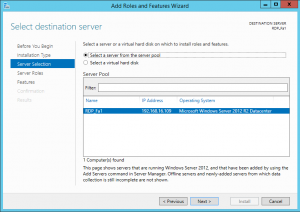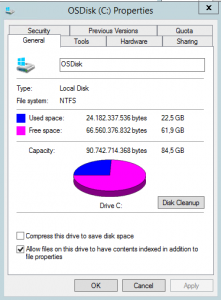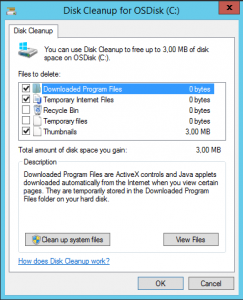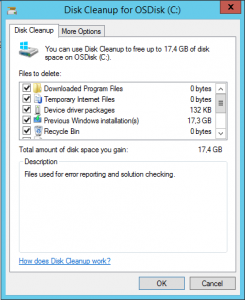Microsoft published a new tool for managing Exchange Activesync functionalities. The tool is dedicated to administrators who wants to manage the process of remotely erasing mobile devices, list all devices for all users and many other functionalities. It is work on Office 365, Exchange 2010 and Exchange 2013
You can download it form here..
How to remove WIndows.old folder
After Microsoft Windows OS (desktop and server) is upgraded, we can see the folder Windows.old. I agree that this folder in some cases can be very useful, but in most cases it’s only a “bed history residue” and most of us want to remove it. In the desktop operating systems is easy to do this, but in server systems seems that this functionality is missing.
So, it is not true, we just have to install it. Here is the step-by-step guide how we can do that in Windows Server 2012R2 (it is very similar in Server 2012):
Open Server manager and in dashboard click on Add Roles and Features. On installation type select Role-Based or feature-based installation.
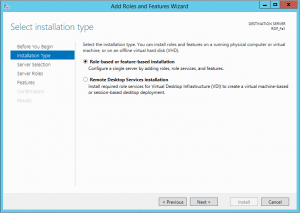
Select the desired server from the server pool.
Select Next on Server Roles and in the Features step check Desktop Experience under User Interfaces and Infrastructure.

Finish the installation, reboot the server and open This PC (My computer). Right click on C disk and select Properties. Now there is the Disk Cleanup button like on desktop operating systems. Click on it.
After the disk cleanup process will finish, you will be able to see a lot of file categories to clean, but there are no system files from the old installation. To discover this type of files, you have to click on Clean up system files.
After this process will finish, you will be able to see all old windows installation files. At this point you have to select them and click on OK.
This will remove all old windows installations and system will looks clean, but before you delete old windows installations be sure, that everything is working with the new OS. After this step it is not possible to go back..
My top 10 in new Essentials server
What is new, cool and bad in Windows Server 2012R2 Essentials? I have my personal top 10 opinion. I don’t want to write only good thinks, because the administrator must know also the dark side of a product. Here is my list:
- Virtualization rights – Server 2012R2 Essentials license include virtualization rights that are different form normal, standard product. These rights include the virtualization 1 + 1. To be more specific, you don’t need to buy an additional license for the host server (if you want to have GUI), but you have to buy it for any additional VM. This will be useful for providing DR scenario in small companies with Hyper-V replica (for example to do it in our datacenter).
- AD Groups – Finally! Microsoft realizes, that user-by-user permissions are not a good approach even in small environments (especially in version 2012, where you were able to translate product to the standard version…). Now we can create groups directly in Dashboard and we can assign permissions to groups and add users to them. It’s fine. Like in the good, old SBS.
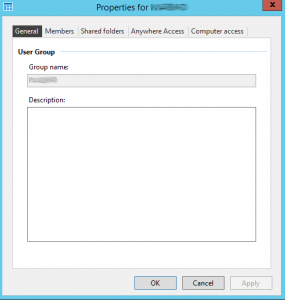
- Essentials role in standard server – Microsoft adds Essentials role to standard products in the way, that if you buy Windows Server 2012R2 Standard or Datacenter edition, you will be able to install the Essentials role. This role will give an opportunity to use Dashboard, Remote Web Workplace and other Essentials functionality. You will be able to use one or more Essentials functionalities, but in some cases, you will be limited with a limit of 100 users (for example in client backups – another good point to limit usage!).
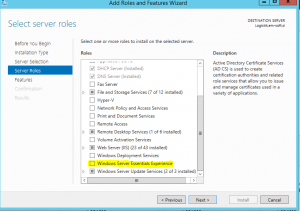
- Client computer backups – Good practice in small companies where you have users, that just use “Save” button and don’t matter where the data is going. This happens in many small companies and no one knows where the data is. In this cases, you have to backup all the environment, including client computers. Very useful functionality.
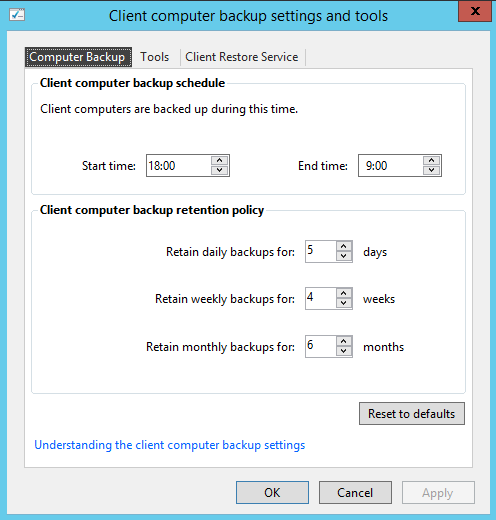
- Azure Backup – We talk again about small businesses. In many cases, the server is located under the table, security is something that they don’t think about and their data are exposed to high risk. Azure backup in those cases is a very good functionality to store crucial company data in a secure location. Of course, this is not a replacement for the normal server backup. We still need to backup our server, because Azure backup will not protect you against accidents like hardware failure or similar. In these cases, you will need a local backup to restore the server quickly.
- Remote Web Workplace – One of my favorite functionalities in Essentials or old SBS server. I use this functionality a lot, I talk a lot about it, but is still buggy. I mentioned this bug in my blog previously and I reported this bug to Microsoft when SBS 2011 public preview was released. From than the bug is still present, so be careful who will have the Administrator rights in your system. It is not really a good point to preserve private data.
- Internal “local” domain – by default is no chance to change FQDN domain from .local to any other domain name. This will be not smart after January 1st, when you will not be able to add local domain to trusted certificates and in many cases this is not a good idea to do it this way. The only way to move away from local domain is installing the Essential role with PowerShell (Break the Essentials wizard and run Start-WssConfigurationService -CompanyName “ContosoTest” -DNSName “ContosoTest.com” -NetBiosName “ContosoTest” -ComputerName “YourServerName” –NewAdminCredential $cred -Setting All from elevated PowerShell).
- Windows Phone and Windows 8 App – Both apps are present from version 2012, but I think, that is a nice approach to have easy access to all data on the server. It is also nice for administrators with quick status report for network. Nice thing.
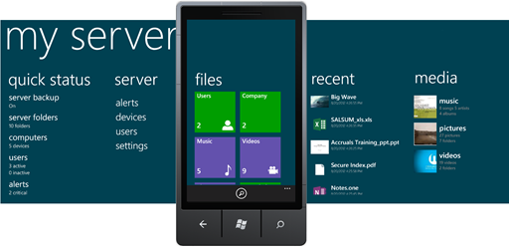
- Health Monitoring and reports – Another thing, that make SBS and Essentials servers popular and easy to manage. Very nice idea to have all events reported on the same screen. In this version is improved with some knowledge results for every error or warning. It is very useful for administrators. The other good functionality of Health monitoring is that it can send E-Mails with health reports and critical errors. One thing I would correct here is the schedule for generating reports; I would like these reports to be generated weekly, not hourly or daily. If you are administrator for more servers, there are too many mails with current configuration.

- Launchpad – Nice application for not so expert users. I think that is very good to advice all users in small companies to use it, because it has a lot of good shortcuts. The first one is access to all shared folders on server without mapping them. This will solve administrator problems like “I cannot see Y drive”. The second nice thing is the list of errors and warnings; including disk space and update warnings. And the last, but not least, is the backup functionality. Unfortunately it is not so good, because a non administrator user can backup his machine, but he is unable to restore some files. This could be corrected.
I hope, that this list will give you a good opinion about this server. Honestly is not a bed product and it is very useful and easy to manage. It is dedicated to small companies and it is made with this logic. Consider it, test it and use it. You will be satisfied with it!.
Group Policy and WMI filtering for OS
Many times, we have to apply some GPO only to particular OS, domain controllers or servers. As we know, this is possible with WMI filtering, but it is very difficult to found all parameters to determinate the operating system in one place. This is why I want to write this post.
When you want to use a WMI filter for query OS, you have to use WMI\CimV2 namespace and there are listed some values that you must know:
Operating system version – we can determinate the version of OS with the variable Version:
Windows Server 2012 Version like “6.2%”
Windows Server 2008 R2 Version like “6.1%”
Windows Server 2008 Version like “6.0%”
Windows Server 2003 Version like “5.2%”
Windows 8 Version like “6.2%”
Windows 7 Version like “6.1%”
Windows Vista Version like “6.0%”
Windows XP (Version like “5.1%” or Version like “5.2%”)
As we can see very quickly, some OS have the same number of OS Version, so we have to adopt the second variable ProductType to have a selection:
Client operating systems ProductType=”1″
Domain controllers ProductType=”2″
Servers that are not domain controllers ProductType=”3″
Now, with the combination of those two variables, we can find only the operating system that we need. However, is it a 32 or 64 bit system? Of course, we can sort also this characteristic with another variable – AddressWidth:
32bit systems AddressWidth = “32”
64bit systems AddressWidth = “64”
At the end, to be more clear, I want to write some examples:
All domain controllers in domain:
select * from Win32_OperatingSystem where ProductType = “3”
All 64 bit Windows 8 OS:
select * from Win32_OperatingSystem where Version like “6.2%” and ProductType = “1” and AddressWidth = “64”
All Windows 2012 servers that are non DC’s:
select * from Win32_OperatingSystem where Version like “6.2%” and ProductType = “3”
Of course, we can filter on many more variables than explained. There are many parameters, which are explained on TechNet and in White papers. For example, we can apply policy (e.g. to install some software) only to computers that have more than 1GB of space on HD:
Select * from Win32_LogicalDisk where FreeSpace > 1073741824 (space is in kb).
Unable to setup Default Printer, error message: 0X00000709
In my environments, in few cases, I had the strange problem with installing and defining a default printer. The situation was, that I was perfectly able to install a printer, but I received a strange error: Unable to setup Default Printer, error message: 0X00000709. My first action was trying to set one of the other printers as a default one, but the error persisted. Then I tried to analyze why and I had a strange result. The nature of the problem was in the registry key HKEY_CURRENT_USER\Software\Microsoft\Windows NT\CurrentVersion\Windows. The error is that it is not possible to change the value of the key Device.
The solution of this problem is to make possible changing the value of the HKEY_CURRENT_USER\Software\Microsoft\Windows NT\CurrentVersion\Windows registry key (in my case it was Read only for all the listed accounts). After I changed the permissions to modify, I was able to define the default printer.
Hope, that I helps someone..
